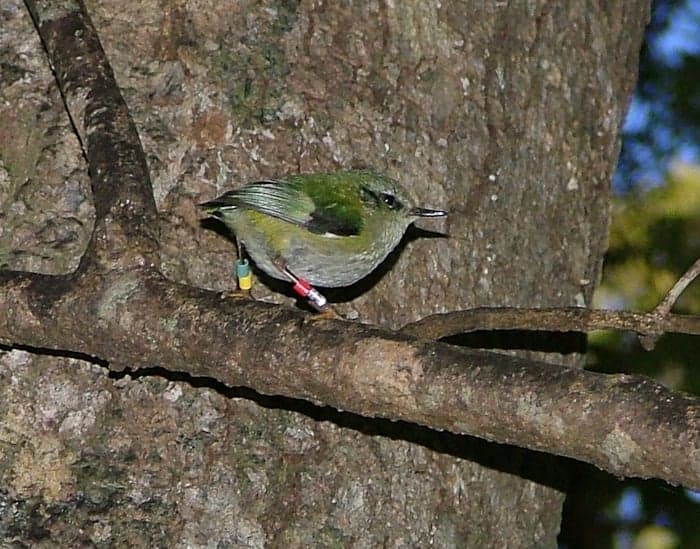Rifleman

Sometimes called a “Bush Wren” they are not apparently a member of the wren family
Riflemanare New Zealands smallest bird, and for me the most difficult to find. Partially because they are so small….. 6 or 7 gram, and at most 80 mm long. Males are bright green on the back, females a duller green/brown, and worst of all for me, their song is pitched too high to be audible. Their squeaky song is around 24000 cps, way above the auditory range of most older males. However as a plus they are extremly active, and it’s usually the movement that catches my eye. Especially around the nest, which is usually in a narrow crevice in a tree, and quite low down. They are insect feeders and will forage on the ground, but more usually work the trunks of trees, generally upwards, spirally around until quite high, then disengaging and flying down to start again.
Rifleman at Nest
[flowplayer src=’https://focusingonwildlife.com/news/wp-content/uploads/2012/06/rifleman-lead-in.mp4′ width=640 height=480 splashend=show splash=’https://focusingonwildlife.com/news/wp-content/uploads/2012/06/rifleman-at-nest.jpg’ autoplay=false]
For me they are very difficult to photograph unless I stake out a nest, but even then focus is a real problem, as a video cameraman friend who I had taken to a nest to film remarked… “the damn bird never sits still for more that a second and a half”. He spent 6 hours in front of that nest and managed around two minutes of usable footage. Eventually just focusing on where he thought the bird might land prior to going into the nest, and hoping.
They are one of the four species reintroduced to Ulva Island post rat eradication, and have apparently done very well. My inability to hear them makes me rely on others observations for this !!. I have once taken a bat detector with me on a walk, and outside a nest was able to dial the machine down from the 40,000 cps it was set to until I could hear the bird at around 24,000 cps.
The name Rifleman comes not as some New Zealanders would try and tell you from a habit of perching on hunters rifle barrels but rather from uniforms the “Green Jackets” or British Rifle Regiments wore during the Peninsula Wars. Rifleman are quite unfased by human beings, as many New Zealand birds are, but equally are not attracted to us… viz Robins and Fantails…. and so would be unlikely to perch on or near people in the forest.
I remember coming across a family… both parents and 4 juveniles, and it was like being in a minor swarm of bumblebees, both from the tiny creatures flitting about, and from the high busy “buzz” of their wings. Did not of course have a camera, and in any case fiddling around with a camera would have quite destroyed the moment.
Peter Tait
Peter Tait is a professional nature guide based at Stewart Island, New Zealand, and he works primarily on Ulva Island Open Sanctuary. Peter has been resident on the Island for over 40 years and was one time Forest Ranger in Charge of Stewart Island. Fishing followed forestry and was in turn followed by Talisker, a 17m charter yacht. He is qualified Skipper Deep Sea Fishing Vessel. In addition to guiding Peter and his wife Iris are hosts at Sails Ashore Lodge.
Leave a Reply